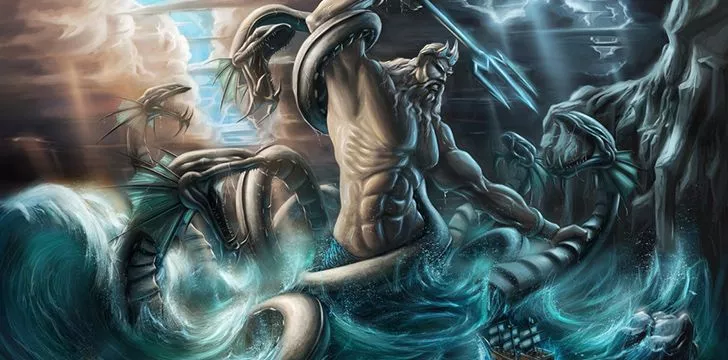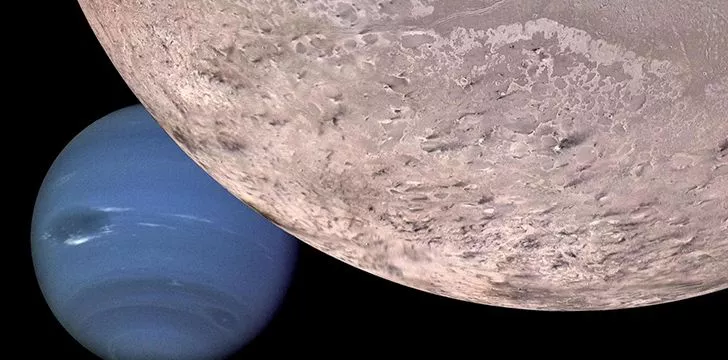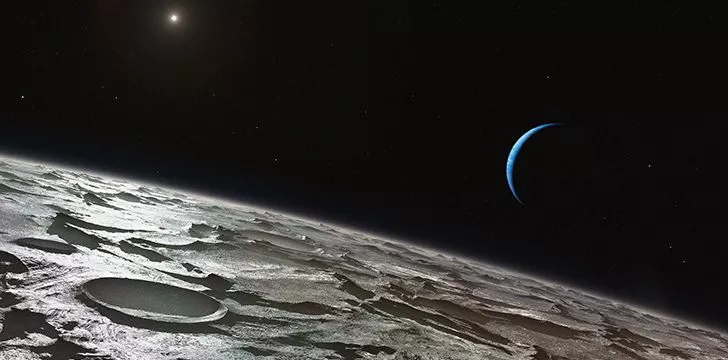Triton, the largest moon of Neptune, has ice volcanoes which are similar to lava volcanoes!
Neptune, the ice giant of our solar system, has six rings and thirteen moons, including Triton.
Triton is not only the biggest moon of Neptune, but also the seventh largest moon and the sixteenth largest object in our solar system with a diameter of 1,682 miles.
Triton was discovered by William Lassell just a few weeks after Neptune was discovered by Alexis Bouvard in 1846.
Triton has over 99.5% of the total mass of all the known bodies orbiting Neptune.
Triton was named after a Greek sea god.

Triton was initially known as the satellite of Neptune until the discovery of Nereid in 1949. It was named after the Greek sea god who was also the son of Poseidon, the equivalent of the Roman god Neptune.
All the moons of Neptune are named after characters from Roman or Greek mythology as per the guidelines of the International Astronomical Union.
Triton has seasons that last for 40 years.

Despite being the farthest planet from the sun, Triton still experiences seasons. Its summer season thickens the atmosphere due to more direct sunlight, while in winter, the atmosphere condenses and falls as snow.
Using the European Southern Observatory’s Very Large Telescope in Chile, scientists confirmed this theory about Triton’s seasons in 2010. The summer solstice on Triton occurred in 2000.
Triton has a frozen nitrogen crust.

About 40% of Triton’s surface is covered by a layer of frozen nitrogen, and it is believed that the rest of its surface is likely to be the same.
Triton, a moon of Neptune, is composed of a layer of frozen nitrogen, carbon dioxide, and regular ice, which gives it a high albedo, reflecting up to 95% of the light that reaches its surface. This is in stark contrast to our moon, which reflects only 11-12% of light. Triton also has tectonic and volcanic activity, resulting in cryovolcanoes, or ice volcanoes, scattered across its surface. These are almost identical to lava volcanoes found on Earth. Additionally, Triton features geysers that erupt nitrogen into the atmosphere, a process unique to this moon. These fascinating facts were obtained from Voyager 2’s flyby in 1989, which is impressive considering the limited technology available at the time. A future mission to Triton could yield even more discoveries.
FAQ
1. What is Triton?
Triton is the largest moon of the planet Neptune. It was discovered by British astronomer William Lassell in 1846, just 17 days after Neptune’s discovery. Triton is unusual for a moon because it orbits Neptune in the opposite direction of Neptune’s rotation, which is known as a retrograde orbit. It is also one of the coldest objects in the Solar System, with surface temperatures reaching as low as -235 degrees Celsius.
2. How big is Triton compared to Earth?
Triton is slightly larger than Earth’s moon, with a diameter of 2,700 kilometers. However, it is much denser than Earth’s moon, which suggests that it is made up of different types of materials. Triton is also the seventh-largest moon in the Solar System.
3. What is Triton’s atmosphere like?
Triton has a very thin atmosphere, composed mainly of nitrogen gas with traces of methane. The atmosphere is thought to be formed by the sublimation of nitrogen ice from Triton’s surface. This means that when the surface temperature rises, the nitrogen ice turns directly into gas, creating a temporary atmosphere. The atmosphere can reach heights of up to 800 kilometers above the surface.
4. Are there any geological features on Triton?
Yes, Triton has a number of interesting geological features, including volcanic eruptions, geysers, and ice volcanoes. The surface of Triton is also covered in a variety of terrains, including smooth plains, ridges, and impact craters. Scientists believe that Triton’s geological activity is caused by the tidal forces of Neptune’s gravity, which create internal heat and pressure.
5. Is there any evidence of water on Triton?
Yes, there is evidence of water on Triton in the form of ice. In fact, Triton is one of the few objects in the Solar System outside of Earth that has a subsurface ocean. The ocean is believed to be composed of water and ammonia, and is kept liquid by the heat generated by tidal forces. Scientists are interested in studying Triton’s subsurface ocean to learn more about the potential for life in the outer Solar System.

Zayn Anderson is a prolific writer with a passion for uncovering the world’s intriguing facts. Armed with an insatiable curiosity, he delves into various subjects, from history and science to nature and technology.
